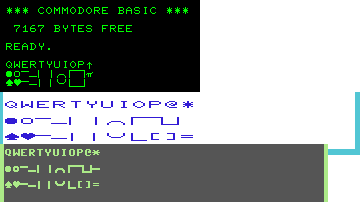CBM-ASCII

Petscii even PET ASCII or PETSCII called, is an eight- bit comprehensive special form of ASCII standards that all 8-bit - computers (home as well as office computers) from Commodore was used and adapted to the requirements of these devices was. (The 16-bit computers from Commodore, including the Commodore Amiga models and the Commodore PCs , did not use CBM-ASCII, but standard ASCII or an 8-bit extension of the same).
PET-ASCII is based on the 1963 version of ASCII, not the 1967 version used by almost all other ASCII computers. This is expressed u. a. in the characters "arrow up" and "arrow to the left" as well as in the all-upper case mode, since lower case letters were not yet intended in ASCII 1963.
There are two modes, one with uppercase letters and special graphic characters and one with uppercase and lowercase letters. In the second mode, compared to the ASCII character set, the positions of the upper and lower case letters are swapped and the upper case letters are shifted to higher codes, so that each upper case letter is created by adding 64 to the lower case code. There were serious changes in the transition from the Commodore BASIC of the PET 2001 to the Commodore Basic V2 afterwards, especially with regard to the coding of lower and upper case letters.
Under block graphics you can read some details about the representations made possible with the capital letters / graphic characters mode.
In the internal memory representation of Basic programs, codes greater than 127 are interpreted as tokens for the Basic commands if they are not in quotation marks.
Another encoding is used in video memory. Only 128 (7 bit) different characters can be displayed at a time, and the 8th bit controls the reverse display of the character. The uppercase letter set is mirrored on the lowest 32 ASCII codes, which otherwise only contain non-printable control characters; the lower case letter set starts at position 64, where the upper case letters are otherwise. This also applies to text mode. In the block graphics mode, the upper half of the code (with the lower case letters) is replaced by graphic characters.
Although the graphic representation of the character set in the Commodore computers is always based on an 8 × 8 pixel matrix, this is only used up to 7 × 7 pixels in the standard characters. The last pixel horizontally and vertically is used as a spacing pixel, so that successive characters are not displayed "glued together". In the case of the "graphic characters", however, the 8 × 8 pixels are fully used. In the predecessor of the C64, the VC-20 , the characters are displayed much wider due to the screen resolution.
literature
- Brian Bagnall: On the Edge. The Spectacular Rise and Fall of Commodore. Variant Press, Winnipeg 2005, ISBN 0-9738649-0-7 , pp. 43, 54-55.
Web links
Individual evidence
- ^ Stephen Murrell: Standard ASCII codes . University of Miami. Retrieved April 4, 2013.
